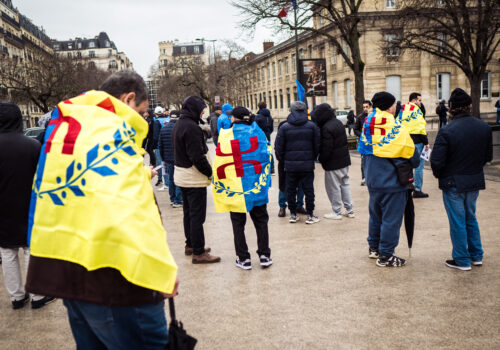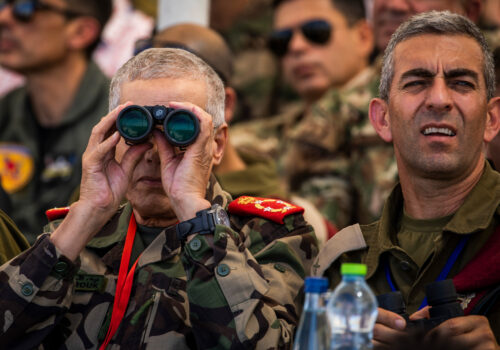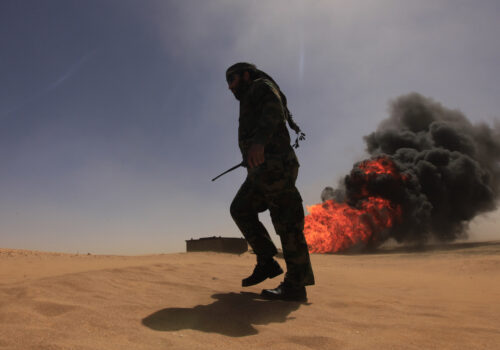Why it’s time to terminate the UN’s dysfunctional mission in Western Sahara
Morocco’s Minister of Foreign Affairs Nasser Bourita made his debut on April 8 with US President Donald Trump’s new administration. In meetings with both Secretary of State Marco Rubio and National Security Advisor Mike Waltz, the Moroccans came to Washington with a clear mission: seeking reassurance that Trump’s position on the Western Sahara conflict will pick up where it was left off with his previous administration in 2020. The delegation from Rabat received its answer.
“The Secretary reiterated that the United States recognizes Moroccan sovereignty over Western Sahara and supports Morocco’s serious, credible, and realistic Autonomy Proposal as the only basis for a just and lasting solution to the dispute,” reads the statement issued by the State Department after the visit. Nevertheless, one obstacle persists: Dismantling the obsolete and dysfunctional United Nations Mission for the Referendum in Western Sahara (MINURSO).
This time, the United States went further by urging the parties to engage in discussions without delay, stating that Morocco’s Autonomy Plan is the only acceptable framework for dialogue. Rubio even stepped up to offer to facilitate the process, signaling that the only way out of this fifty-year colonial impasse may be outside the United Nations and its legacy of failure to secure a sustainable solution for the Sahraoui people.
A mission without a mandate
As its name stipulates, the United Nations Mission for the Referendum in Western Sahara was initially established in 1991 by Security Council resolution 690 to prepare for a referendum in which the people of Western Sahara would choose between independence and integration with Morocco. However, the mission failed to deliver on its mandate and only served to maintain a state of paralysis throughout the years. It is essential to clarify that while the MINURSO monitors the ceasefire, which still holds for nearly thirty-five years between Morocco and the Polisario Front separatists, it is in no way an active peacekeeping mission, and Morocco continues to administer de facto over 80 percent of the Western Saharan disputed territories since the Spanish exit in 1975. MINURSO staff remained spectators, even during the rare skirmishes that were reignited along the sand wall, when Morocco decided to retake the strategic Guerguerat crossing in November 2020 to open trade routes with Mauritania.
Staffan de Mistura, the United Nations Secretary-General envoy to Western Sahara, was set for defeat from the start. Since 2022, de Mistura has felt out of place in a fast-moving international context, shifting in favor of Morocco.
First, the United States recognized Rabat’s sovereignty over Western Sahara in conjunction with re-establishing diplomatic ties between Morocco and Israel in December 2020, knocking down the chessboard in a fragile geopolitical context where MINURSO had maintained the status quo between Morocco and Algeria.
SIGN UP FOR THIS WEEK IN THE MIDEAST NEWSLETTER
Then came the coup de grace by the two former colonizers of Morocco and Western Sahara, who are at the source of the current superfluous borders, when Spain sided with Morocco in 2022. France followed in 2024, and over twenty-nine countries decided to open diplomatic representations in Western Sahara as a sign of support for the Moroccan stance.
The Italian diplomat himself indicated in October 2024 his intention to step down, alluding to his inability to mediate between a Morocco emboldened by overwhelming international support and an Algeria obstinate in supporting the mirage of Sahraoui self-determination until the very end. In his latest faux pas, Staffan de Mistura proposed the partition of Western Sahara, suggesting that the envoy and the MINURSO are neocolonial instruments from the past, wasting a sixty-one million dollar annual budget, funded in majority by the United States.
Another flagrant example of MINURSO’s irrelevance is how the disputed Western Sahara borders have been, for decades, uncharted territories for terrorist activities from al-Qaeda to the Islamic State in Iraq and the Levant (ISIS) and, more recently, a fertile ground for Iranian and Russian influence. Besides gathering intel and filing situation reports, the Mission has done very little to address the flourishing drug and human trafficking business in the disputed territories, leaving this task to the Moroccan and Algerian military.
The diversion of humanitarian aid destined for Sahrawis in the camps in Tindouf, Algeria, also continues to raise concerns, especially with evidence showing that much of the aid is subject to corruption and reselling in open markets like Nouadhibou in Northern Mauritania.
The impracticality of a Sahraoui referendum
Several founding myths surround the Western Sahara file, making a referendum a preposterous and impractical solution—a reality that Western allies like the United States started grasping in recent years.
Contrary to other conflicts, where Indigenous people claim the right to self-determination based on their distinct cultural identity, the Saharaoui people are not native to North Africa. The Arab tribes of Beni Hassan, who trace their ancestry to the Yemeni tribe of Maqil, started moving westward to the Maghreb around the thirteenth century, invited by the Almohad empire of Morocco that needed to reinforce its rule by balancing the Amazigh tribe with the Arab warrior populations. If anything, the Hassani people were the ones who pushed the Indigenous Amazigh tribal confederation of Sanhaja out of the Sahara after the massacre of Char Bouba War in the seventeenth century.
The Hassani people today are transnational communities inhabiting large sections of Mauritania, Algeria, Morocco, and Western Sahara—hence the impossibility of carrying out a census of who gets to participate in a referendum. To complicate things further for the MINURSO, the Alaouite sultan Moulay Ismail had established the “Guich System”, a feudal system where these very Hassani tribes were used to counter Amazigh rebellions in exchange for land up to the nineteenth century. The descendants of these fighters still live around the capital, Rabat, Marrakech, and Sidi Kacem, and still assert their Sahraoui roots.
In the Moroccan-administered portion of the territory, the central state had additionally provided generous incentives, including double salaries and subsidized gas and essential subsistence items, since the seventies for those willing to relocate to the Sahara, and two generations at least have been in the disputed land. Even in the five refugee camps in Algeria, where about 173,600 individuals still live, it is extremely hard to determine who is a Saharaoui and who came to Tindouf as a result of a multitude of other conflicts in the Sahel. Due to all these complexities, the MINORSO has consistently failed since its establishment to come up with voter lists that would be acceptable to all parties, thereby nullifying the prospects of a referendum and the relevance of a UN Mission entrusted to organize it.
What many Sahraoui people want
In a recent field study in July 2024 to Dakhla, Laayoun, and Boujdour, I covered nearly four hundred miles and spoke to dozens of civil society activists, journalists, officials, and ordinary Sahraoui people from my own tribesmen of Oulad Dlim. Most interviewees in the Moroccan-administered portion of Western Sahara (about 1.1 million inhabitants according to the September 2024 census) expressed extreme fatigue from five decades of conflict and a desire for normality and prosperity. They seemed more hopeful for a sustainable resolution through the Moroccan federal advanced regionalization plan proposed in 2006, which preserves their cultural identity and gives them sovereignty over local governance and natural resources under the Moroccan flag.
It was interesting to observe the shift in the Moroccan strategy toward the Sahara conflict, transcending the purely security approach under Driss al-Basri in the 1990s, beating and arresting demonstrators, to a vision focusing on regional development, a dynamic tourism sector, and the looming hope of the $1.2 billion Dakhla Atlantic harbor megaproject—the cornerstone of the kingdom’s Atlantic Initiative. This recent economic boom made some interlocutors confident in the future, although many stated that Morocco hasn’t provided any details of how the autonomy plan will work in practice and how much control they will have over their natural resources. It’s important to note that the research didn’t include Sahrawis in the camps, who may remain attached to self-determination after five decades on a different trajectory.
For the past thirty-four years, MINURSO has consistently deceived the Sahrawi people by failing to deliver on its mission, promoting a laissez-faire culture, and holding hundreds of thousands hostage to complicated geopolitical calculus. Now, the time is up, and the Sahrawi communities can no longer afford another fifty years of political stalemate. The parties to the conflict, along with US and trans-Atlantic allies, will need to defund, dismantle, and terminate it so the autonomy plan can start taking shape.
In The Revenge of Geography, Robert D. Kaplan said that “borders are not just lines on a map; they are a reflection of power dynamics,” and today’s dynamics are calling for greater accountability for UN programs like the MINURSO and for out-of-the-box decisive solutions under Trump’s leadership.
Sarah Zaaimi is a resident senior fellow for North Africa at the Atlantic Council’s Rafik Hariri Center and Middle East programs, focusing on the Western Sahara conflict. She is also the center’s deputy director for media and communications.
Further reading
Thu, Jan 30, 2025
The roots of recent Algeria-France tensions are deeper than it may seem
MENASource By
Algeria’s fear of growing international isolation, coupled with growing internal tensions in French domestic politics, risk aggravating misunderstandings between the two countries.
Tue, Jan 21, 2025
How the Gaza war brought Morocco and Israel closer
MENASource By Sarah Zaaimi
Security cooperation between Israel and Morocco is flourishing and has never been stronger, driven by a common Iranian threat and a shared vision for regional integration.
Wed, Apr 2, 2025
Libya’s political deadlock endures. There is a case for Trump and Meloni to challenge the status quo.
MENASource By
The political crisis in Libya is one that the US and Italy may be uniquely postured, and incentivized, to quell.
Image: A Sahrawi woman walks with a boy near Moroccan police in Laayounne in the disputed territory of Western Sahara. A Sahrawi woman walks with a boy as Moroccan police, called in to quell further riots, stand guard behind them in Laayounne in the disputed territory of Western Sahara, June 7, 2005. Moroccan authorities said on May 29 that 33 youths had been charged with taking part in riots in the vast territory Morocco seized after colonial power Spain withdrew in 1975. The Polisario Front, which seeks independence for Western Sahara, conducted a low-intensity guerrilla war until the United Nations brokered a ceasefire in 1991, with the promise of holding a referendum to decide the territory's fate, but disagreements over voter eligibility have prevented the vote from taking place.



